I am posting a comment I made to Ray Tomes on WUWT that may be a useful reference article. Ray is heavily involved in cycle research using a variety of tools that exposes repeating patterns in data records. One repeating pattern that shows up in the solar proxy record over the Holocene (the last 11,000 years) is around 208 years, but I explain this value is really an artifact of another underlying cycle that will never show in spectral analysis.
----------------------------------------------------------------------------------------------------------------------------------------------------------------------------
Ray Tomes says:
November 11, 2012 at 11:47 pm
Ray: How do you get from 172 years (U-N synodic cycle) to 208 years? These two cycles make beats every ~1000 years which is also not a meaningful planetary cycle.
Geoff: Think of the 3 prongs on the hour hand.
Ray: Sorry Geoff, I have a digital watch. You will need to explain this in a bit more detail please.
I will try to explain.
Look at the altered path of the Sun drawn in green on the following diagram.

The altered path coincides with ALL grand minima events through the Holocene, but they differ in intensity. The next diagram shows the only planetary position that can cause the altered path.

Now the important bit, that I am sure you will understand. The planetary position displayed previously which I call the AMP event can happen 3 times (most common) every time Neptune & Uranus are together. The strength of each AMP event is what determines the length and depth of the grand minimum of that particular cycle (N/U cycle). This is the 3 prongs on the hour hand of the 172 year clock, each prong is separated by around 40 years. Because most of the Holocene has weaker forms of grand minima and by using other methods we can determine that most of the time all three prongs are NOT strong. This gives the gaps between grand minima like witnessed with today’s oncoming grand minimum and the Dalton that is most common (210 years). The 3 chances to invoke solar slowdown is the key and why FFT analysis will not see the complete picture because of the multiple options involved. There are no precise cycles when it comes to grand minima.
This should be an eye opening revelation if understood.
-----------------------------------------------------------------------------------------------------------------------------------------------------------------------------
The other method mentioned of course is Carl's graph which shows us how many AMP events per each 172 year cycle along with the strength of each "prong". The green arrows line up with the green orbit changes shown on the 1st image above. Note that there are only 2 prongs (green arrows) this time around, one weak event at 1970 and a medium event right now.
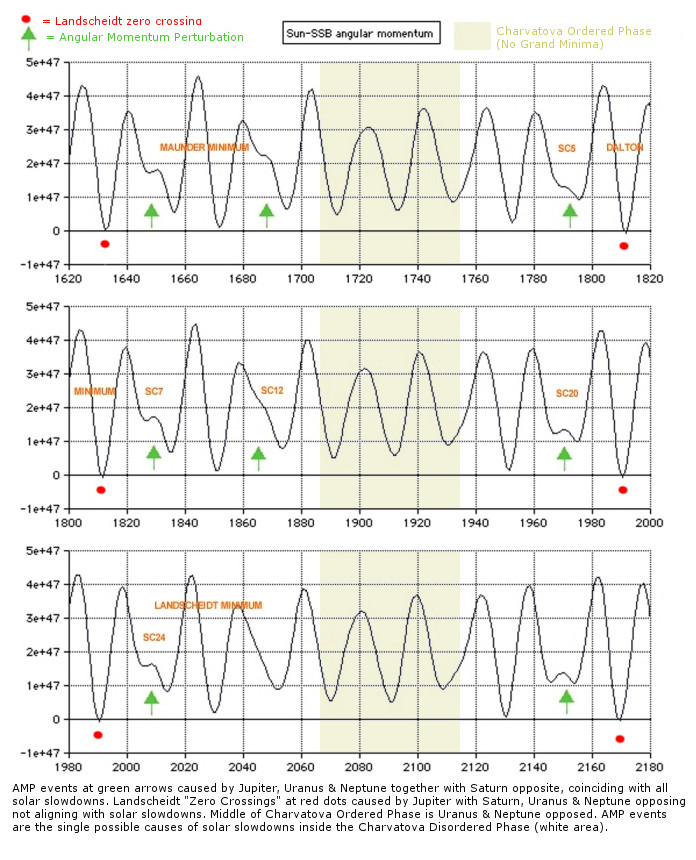

The above graph better illustrates the swinging trident hand (most times 3) that comes along every 172 years average. Click for a full sized view.
This graph also proves an issue that is contentious to some, which axis point does Jupiter orbit? The graph is almost identical to the solar angular momentum and solar distance to SSB graph and displays the difference between Jup-Sun and Jup -SSB. For all graphs to agree Jupiter must be anchored to the Sun while the differences to the SSB are the actual distance the planets move the Sun away from the SSB.
-----------------------------------------------------------------------------------------------------------------------------------------------------------------------------
Extra Notes:
On the last graph there is a linear trend line that shows a flat trajectory thus demonstrating a balanced system. The perturbations shown at the green arrows can be judged in strength by the distance below the orange line. The strong perturbations like in 1650 show a high position relative to the trend line where the position or AM reverses. The blue value line is declining then rising before falling again after the perturbation. Weak and strong perturbations both show a disordered inner orbit but the difference is how much of the inner orbit is higher than the radius of the Sun measured from the SSB (shown in 1st diagram). In other words the inner orbit is trying to be an outer orbit before returning, the higher the orbit the higher the perturbation.
I think this can be determined to be a new retrograde orbit or movement (solar path is moving away from SSB instead of moving closer) quite distinct from the "zero crossing" variant that Landscheidt used.
Some further research has revealed a specific solar orbit pattern that I think deserves a new classification. These special events show a Sun that is neither accelerating or decelerating for upto a decade which must upset the normal cycle that I think is governed by deceleration/acceleration. These "Type C" events are not common but do coincide with substantial drops in solar activity over the Holocene. Below is a plot of one of these interesting events in -1045.
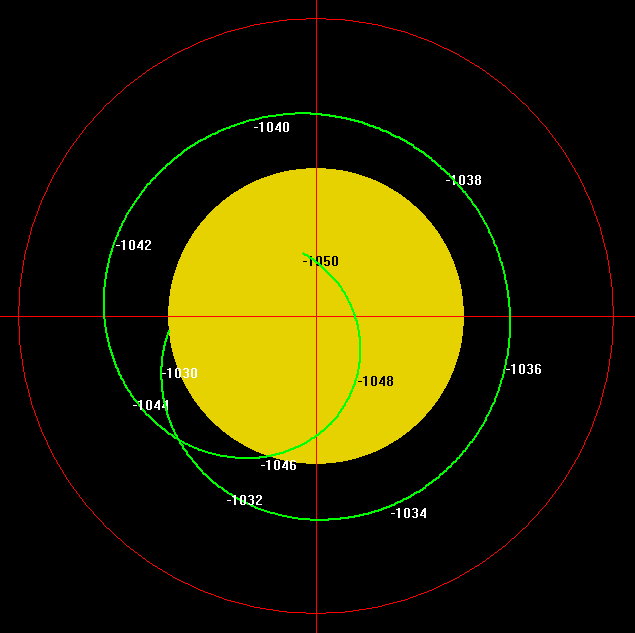
The AM diagram below shows the Type C event at -1045 which is characterized by a shallow dome appearance. At around -850 a similar event takes place that is followed by 3 strong Type A events, this combination looks to have caused the largest drop in solar activity over the Holocene.

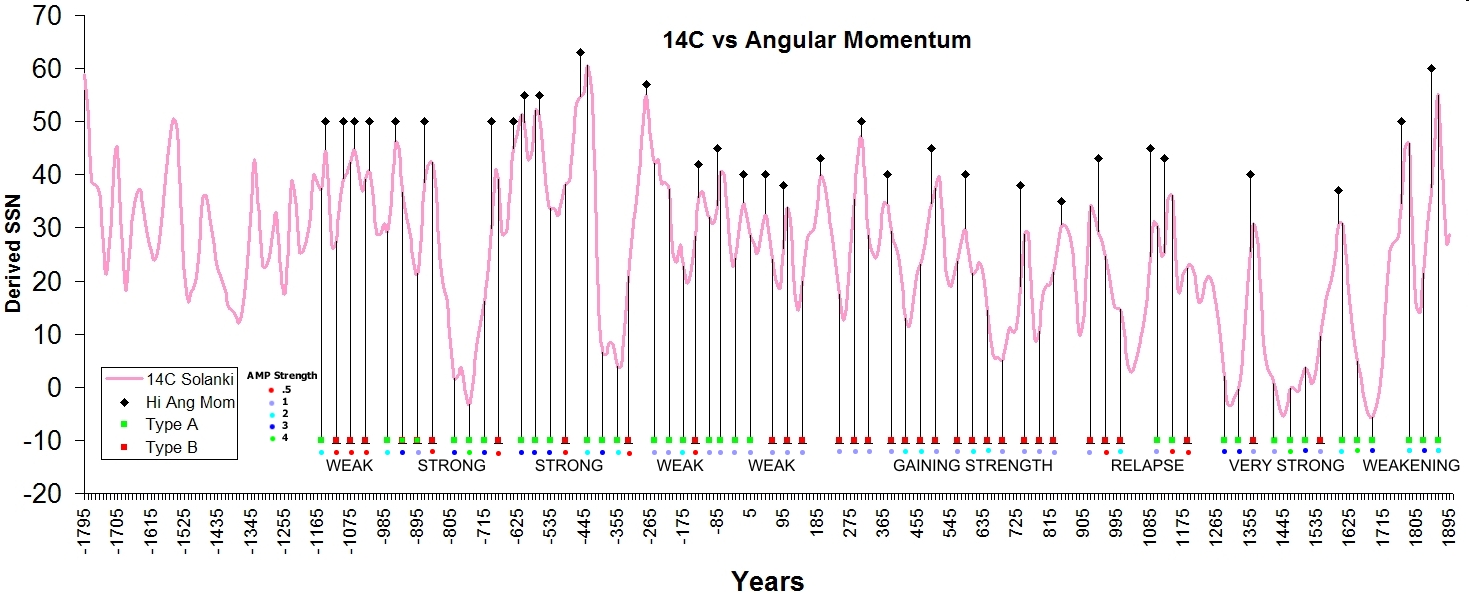
AMP events vary in strength and when they occur in the Jupiter/Saturn oscillation. AMP events seem to be not linked to the actual rise and fall of a solar cycle, the timing of the AMP event in respect to where it falls in the solar cycle is important. There is a lot of evidence that suggests the best timing for maximum AMP damage is late in the previous cycle. Just before cycle max tends to waste most of the event as seen at 1830 and to some extent 1970.


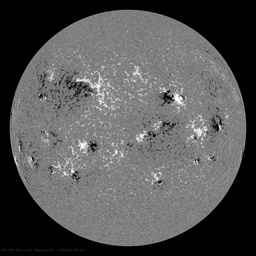
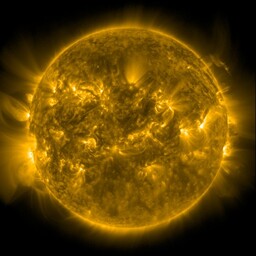

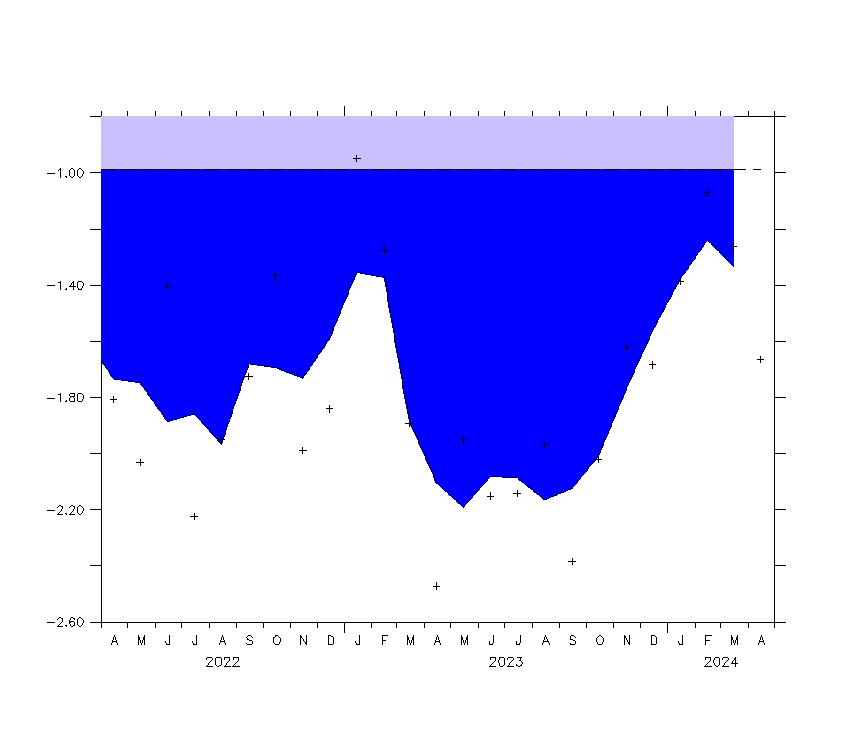
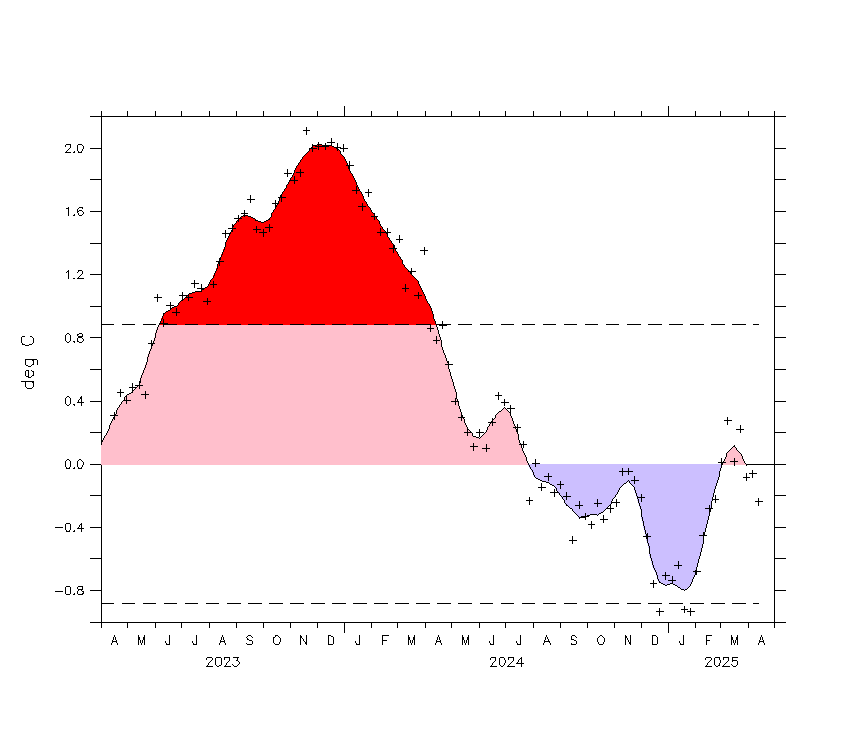
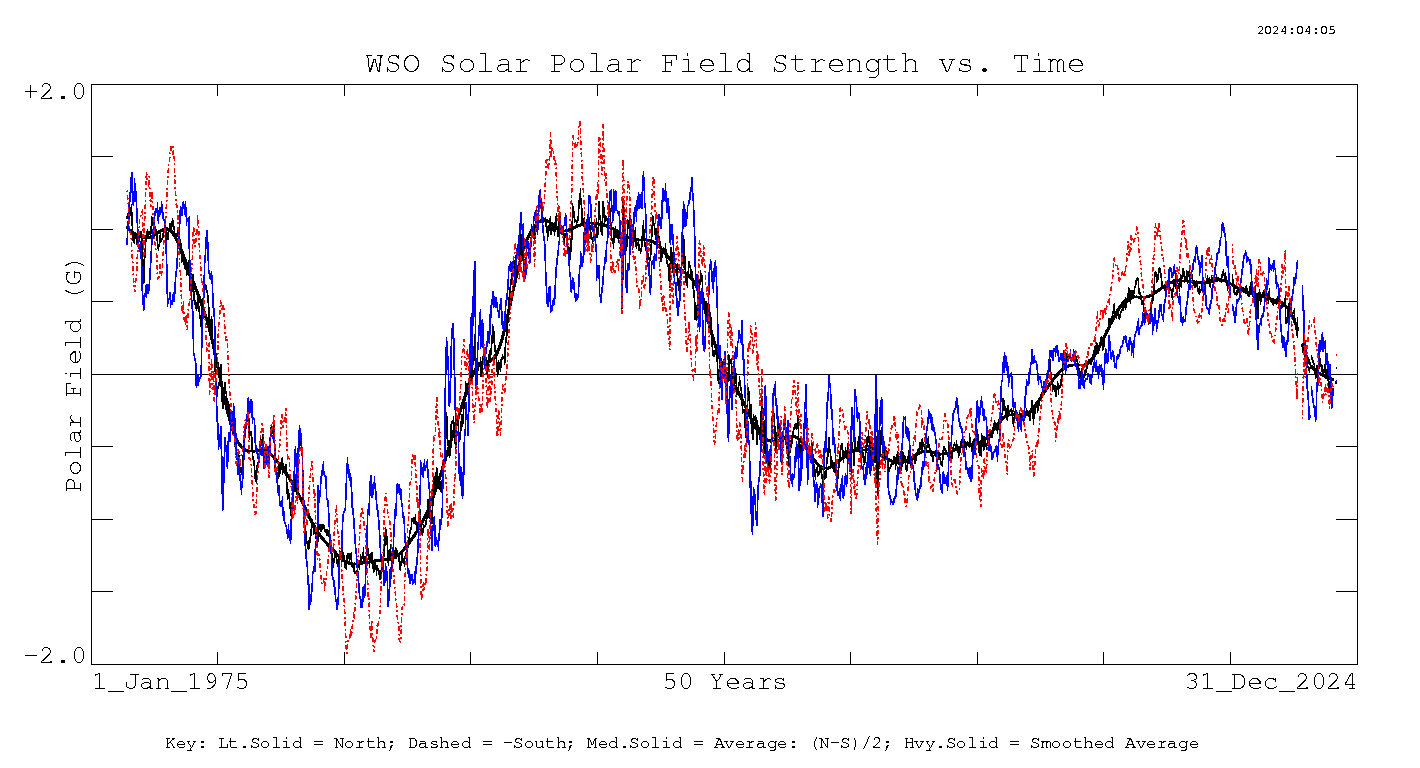
I am posting a comment I made to Ray Tomes on WUWT that may be a useful reference article. Ray is heavily involved in cycle research using a variety of tools that exposes repeating patterns in data records. One repeating pattern that shows up in the solar proxy record over the Holocene (the last 11,000 years) is around 208 years, but I explain this value is really an artifact of another underlying cycle that will never show in spectral analysis.
----------------------------------------------------------------------------------------------------------------------------------------------------------------------------
Ray Tomes says:
November 11, 2012 at 11:47 pm
Ray: How do you get from 172 years (U-N synodic cycle) to 208 years? These two cycles make beats every ~1000 years which is also not a meaningful planetary cycle.
Geoff: Think of the 3 prongs on the hour hand.
Ray: Sorry Geoff, I have a digital watch. You will need to explain this in a bit more detail please.
I will try to explain.
Look at the altered path of the Sun drawn in green on the following diagram.
The altered path coincides with ALL grand minima events through the Holocene, but they differ in intensity. The next diagram shows the only planetary position that can cause the altered path.
Now the important bit, that I am sure you will understand. The planetary position displayed previously which I call the AMP event can happen 3 times (most common) every time Neptune & Uranus are together. The strength of each AMP event is what determines the length and depth of the grand minimum of that particular cycle (N/U cycle). This is the 3 prongs on the hour hand of the 172 year clock, each prong is separated by around 40 years. Because most of the Holocene has weaker forms of grand minima and by using other methods we can determine that most of the time all three prongs are NOT strong. This gives the gaps between grand minima like witnessed with today’s oncoming grand minimum and the Dalton that is most common (210 years). The 3 chances to invoke solar slowdown is the key and why FFT analysis will not see the complete picture because of the multiple options involved. There are no precise cycles when it comes to grand minima.
This should be an eye opening revelation if understood.
-----------------------------------------------------------------------------------------------------------------------------------------------------------------------------
The other method mentioned of course is Carl's graph which shows us how many AMP events per each 172 year cycle along with the strength of each "prong". The green arrows line up with the green orbit changes shown on the 1st image above. Note that there are only 2 prongs (green arrows) this time around, one weak event at 1970 and a medium event right now.
The above graph better illustrates the swinging trident hand (most times 3) that comes along every 172 years average. Click for a full sized view.
This graph also proves an issue that is contentious to some, which axis point does Jupiter orbit? The graph is almost identical to the solar angular momentum and solar distance to SSB graph and displays the difference between Jup-Sun and Jup -SSB. For all graphs to agree Jupiter must be anchored to the Sun while the differences to the SSB are the actual distance the planets move the Sun away from the SSB.
-----------------------------------------------------------------------------------------------------------------------------------------------------------------------------
Extra Notes:
On the last graph there is a linear trend line that shows a flat trajectory thus demonstrating a balanced system. The perturbations shown at the green arrows can be judged in strength by the distance below the orange line. The strong perturbations like in 1650 show a high position relative to the trend line where the position or AM reverses. The blue value line is declining then rising before falling again after the perturbation. Weak and strong perturbations both show a disordered inner orbit but the difference is how much of the inner orbit is higher than the radius of the Sun measured from the SSB (shown in 1st diagram). In other words the inner orbit is trying to be an outer orbit before returning, the higher the orbit the higher the perturbation.
I think this can be determined to be a new retrograde orbit or movement (solar path is moving away from SSB instead of moving closer) quite distinct from the "zero crossing" variant that Landscheidt used.
Some further research has revealed a specific solar orbit pattern that I think deserves a new classification. These special events show a Sun that is neither accelerating or decelerating for upto a decade which must upset the normal cycle that I think is governed by deceleration/acceleration. These "Type C" events are not common but do coincide with substantial drops in solar activity over the Holocene. Below is a plot of one of these interesting events in -1045.
The AM diagram below shows the Type C event at -1045 which is characterized by a shallow dome appearance. At around -850 a similar event takes place that is followed by 3 strong Type A events, this combination looks to have caused the largest drop in solar activity over the Holocene.
AMP events vary in strength and when they occur in the Jupiter/Saturn oscillation. AMP events seem to be not linked to the actual rise and fall of a solar cycle, the timing of the AMP event in respect to where it falls in the solar cycle is important. There is a lot of evidence that suggests the best timing for maximum AMP damage is late in the previous cycle. Just before cycle max tends to waste most of the event as seen at 1830 and to some extent 1970.